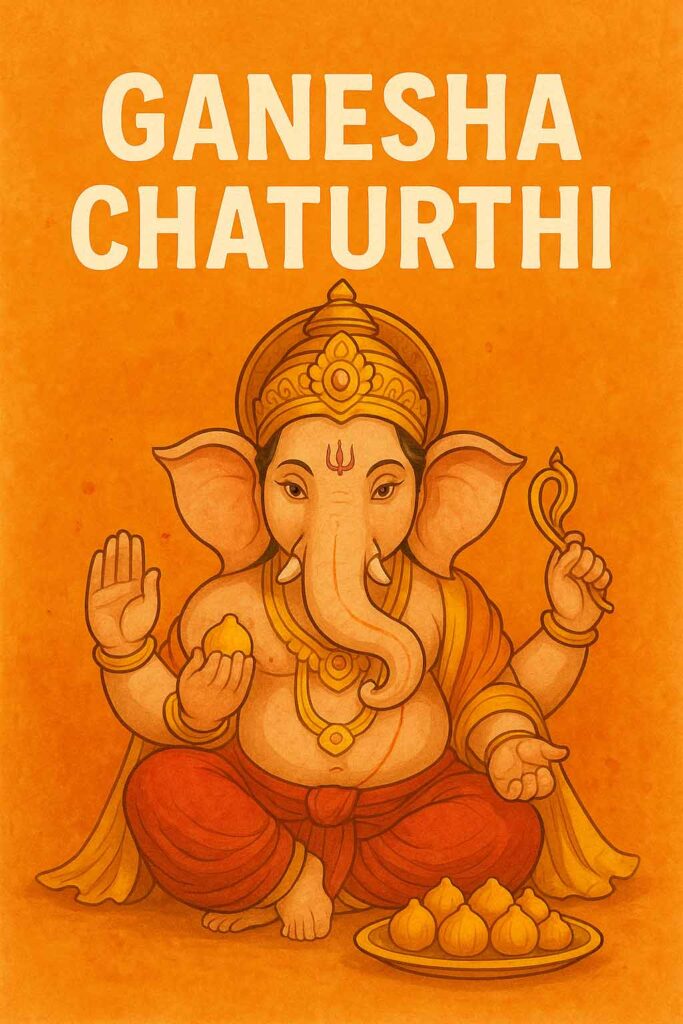Ganesh Chaturthi (August–September)
Birth of Lord Ganesha, remover of obstacles.

Ganesh Chaturthi:The Festival of Lord Ganesha
Vinayaka Chaturthi, also widely known as Vinayaka Chaturthi, is one of the most celebrated Hindu festivals in India, honoring the birth of Lord Ganesha, the beloved elephant-headed deity who symbolizes wisdom, prosperity, and the removal of obstacles. The festival typically falls in the Hindu month of Bhadrapada (August–September), beginning on the fourth day of the waxing moon (Shukla Paksha Chaturthi). It is celebrated with immense devotion, enthusiasm, and grandeur across India, especially in states like Maharashtra, Karnataka, Andhra Pradesh, Tamil Nadu, and Goa. The joyous energy of Vinayaka Chaturthi spreads far beyond temples and homes, bringing communities together in a vibrant display of faith and festivity.
According to Hindu mythology, the origin of Lord Ganesha’s birth is both divine and symbolic. Goddess Parvati, the consort of Lord Shiva, created Ganesha from sandalwood paste to guard her while she bathed. When Lord Shiva returned and found the young boy blocking his path, unaware that he was Parvati’s creation, he became enraged and beheaded him. Upon seeing Parvati’s grief, Shiva promised to restore the boy’s life and replaced his head with that of an elephant. From that moment, Lord Ganesha became revered as the God of Wisdom, Intellect, and Prosperity, and was blessed to be worshipped first before any major undertaking or ceremony. This myth conveys profound spiritual lessons about humility, forgiveness, and the importance of balance in life.
The celebration of Vinayaka Chaturthi was initially a private household affair but took on a grand public form in the late 19th century, thanks to the visionary leadership of Lokmanya Bal Gangadhar Tilak. During India’s freedom movement, Tilak transformed Ganesha Chaturthi into a community festival to unite people across social and religious divides. He recognized that the worship of Lord Ganesha—an all-embracing deity—could bring people together in solidarity against colonial rule. Since then, the festival has evolved into a magnificent blend of devotion, culture, art, and social unity.
Preparations for Vinayaka Chaturthi begin weeks in advance. Skilled artisans craft intricate Ganesha idols in various sizes, often from clay or eco-friendly materials. The idols are beautifully decorated and installed in homes, temples, and large community pandals (temporary shrines) amid chanting of Vedic hymns and mantras. The atmosphere fills with devotion as families and communities perform Ganapati Puja, offering flowers, coconut, durva grass, and the famous sweet modak, which is considered Lord Ganesha’s favorite. The rituals include daily prayers, bhajans (devotional songs), and aarti (ceremonial worship with lamps), creating an aura of positivity and spiritual joy. Cultural programs, traditional dances, plays, and social gatherings further enrich the celebrations.
Each day of the festival carries deep spiritual meaning. Devotees believe that praying to Lord Ganesha during this period removes negativity and brings success, harmony, and inner peace. On the final day, known as Anant Chaturdashi, devotees perform the Ganesh Visarjan, a grand farewell procession in which the idols are immersed in rivers, lakes, or seas. This ritual represents the cycle of creation and dissolution, reminding people of the impermanence of life. The procession, filled with music, dancing, and chants of “Ganpati Bappa Morya, Pudhchya Varshi Lavkar Ya” (O Lord Ganesha, come again soon next year), is both joyous and emotional, marking the culmination of the festival.
In recent years, there has been a growing emphasis on eco-friendly celebrations. Awareness about the environmental damage caused by plaster-of-Paris idols and chemical paints has led many communities to switch to natural clay idols and organic colors. Additionally, artificial immersion tanks and sustainable decorations are being promoted to preserve water bodies. This shift reflects the festival’s timeless message—respecting nature and living in harmony with creation.
Beyond its religious significance, Vinayaka Chaturthi holds immense cultural and social value. It fosters unity, compassion, and collective responsibility. People from diverse backgrounds come together to organize and participate in events, reinforcing the spirit of inclusivity and devotion. The festival also inspires creativity—through art, music, and community service—making it not just a religious occasion but also a celebration of life itself.
In essence, Vinayaka Chaturthi is more than a festival—it is a celebration of beginnings, wisdom, and renewal. Lord Ganesha’s presence reminds devotees to approach life with clarity, humility, and faith. As the rhythmic beats of drums echo through streets and chants fill the air, the message of Ganesha endures: remove obstacles with patience, seek knowledge with humility, and embrace every challenge with courage and positivity. Whether celebrated in a grand public pandal or a humble home altar, Vinayaka Chaturthi continues to unite hearts, uplift spirits, and spread joy across generations.
